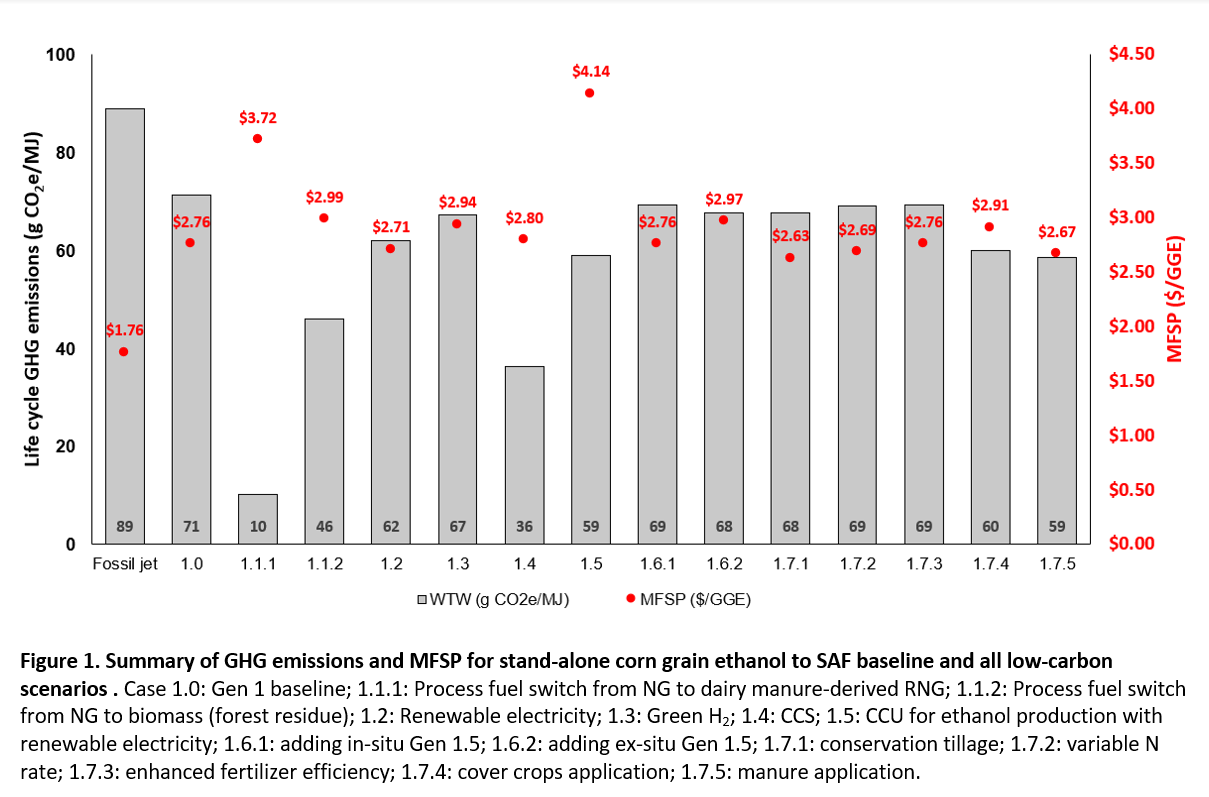Sustainable aviation fuel (SAF) grand challenge, a multiagency effort of the U.S. government, envisions producing 3 billion gallons of SAF by 2030, targeting to reach 35 billion gallons by 2050 with net-zero emissions. Achieving the near-term goal of 3 billion gallons requires utilizing existing biofuel infrastructure and adopting aggressive emission reduction strategies to meet the 50% emission reduction target in the aviation sector. SAF producers can leverage the established corn grain ethanol infrastructure in the U.S. for SAF production. The upward trend of vehicle electrification and fuel economy worldwide, including in the U.S., would shrink the ethanol blend market in the near- term leaving a significant amount of expendable ethanol for SAF upgrading.
Nevertheless, the 50% emissions reduction goals are not realizable using the existing corn grain ethanol supply chain. Current corn grain ethanol to SAF pathway can achieve only a 20% CI score reduction compared to the fossil jet fuel demanding modifications in existing corn farming practices and deployment of smart carbon reduction techniques. However, these modifications might have moderate to significant cost penalties that might be prohibitive for market penetration without policy incentives. For the successful development of large-scale fuel production, it is important to understand the economic and environmental implications of such an effort. This study integrates techno-economic analysis with life cycle assessment to study multiple deep decarbonization technology options for corn grain ethanol to SAF process concepts.
The options for reducing GHG emissions in corn grain ethanol to SAF pathway are replacing fossil NG with RNG or biomass, switching grid electricity to renewable electricity, switching to renewable hydrogen, carbon capture and storage (CCS), and carbon capture and utilization (CCU). Renewable energy sources present the potential to significantly reduce greenhouse gas (GHG) emissions (4.1â61 gCO2e/MJ or 6%â86 % compared to the baseline) at the expense of significantly higher cost. Without considering transportation infrastructure-related expenses, CCS has the potential to significantly reduce GHG emissions (35 gCO2e/MJ), 49% GHG reduction compared to the base case, and with only marginal increases in cost (only $0.13/GGE increase compared to baseline).
Employing CCU is a highly capital-intensive process, and some cost penalties can be offset by a 48% increase in ethanol production. However, high electricity demand for the H2/CO2 electrolysis process leads to a 50% increase in MFSP. Emission reduction is only possible if renewable electricity is used for the CCU process. Given the current state of technology for CCU, further R&D efforts are necessary for commercial-scale deployment.
Since farming activities significantly impact feedstocks' life cycle GHG emissions, this study has included analysis to understand the impact of farming, soil organic carbon, and indirect land use change associated with this corn grain ethanol derived SAF. The investigated sustainable farming practices include conservative tillage, variable nitrogen rate, use of efficient fertilizer, utilizing winter cover crops, and applying livestock manure. GHG emissions reductions for sustainable farming practices vary from 22% to 34%, among which conservation tillage, variable nitrogen rate, and livestock manure have slightly lower cost than the base case. Adopting a single sustainable farming practice does not significantly reduce GHG emissions; however, the reduction contribution can be accumulated by applying multiple options to achieve considerable GHG reduction.

